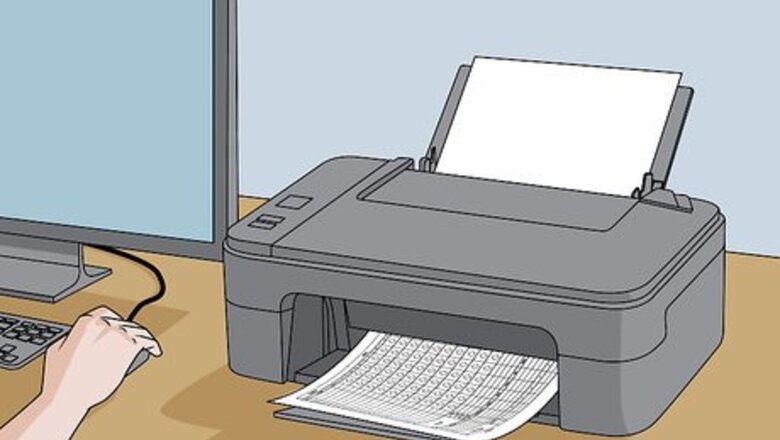
views
Understanding the Scorecard
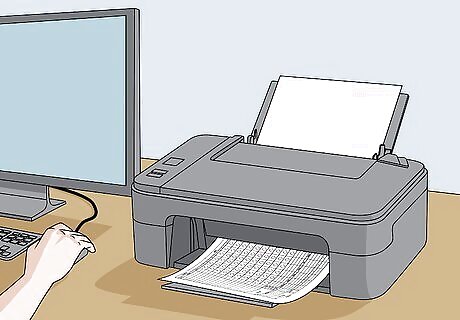
Purchase scorecards in bulk or print them out online. If you’re going to keep score for your child’s or friend’s team, you’re going to need a lot of scorecards. Find a design that looks clean and easy to understand and order them in bulk from a sports equipment store or online shop. You can also print a bunch of free templates out if you prefer. This way, you’ll always use the same design. You don’t need to worry about different sheets being radically different—baseball scorecards are universal in terms of the information that they contain, even if the design is a little different. The differences between different sheets are pretty minor. If you’re keeping score at the ballpark to enjoy a professional or minor league game, ask an usher for a scorecard. They typically give them out for free or sell them for cheap.
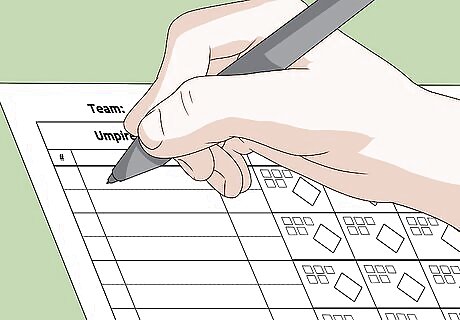
Use an offical roster to fill in the batting lineup on the left. You use one scorecard per lineup. The column on the left labeled “player” is where you will list the batting lineup, with the first batter at the top and the ninth batter at the bottom. Each row has an extra line underneath it in case a player is replaced mid-game. If you don’t know the player’s names, you can use their jersey numbers instead. If you’re scoring little league games where there are lots of substitutions, find a scorecard with 3 or 4 lines per player. You only track 1 team’s performance on a single scorecard. If you want to score both teams, use 2 separate cards. There are some scorecards that are double-sided so that you can track both teams on one sheet. There is usually a column on the left of a player’s name for their jersey number. The “Pos” column on the right is shorthand for “position” so that you can enter the player’s fielding position. There is often an extra row at the bottom for a tenth player in case your team uses a pinch hitter or your screw up on a row. Some scorekeepers use this row to take notes.
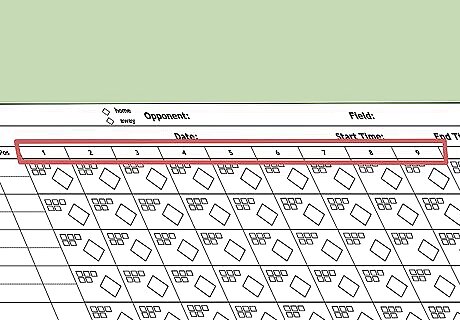
Identify the inning columns at the top. Look at the row above the diamonds that are printed all over the page. You will see the numbers 1-9 listed above each column. These represent the total number of innings in a game of baseball. Every time that your team comes up to bat in a new inning, you’ll move to the next column to indicate that it is a new inning. You work from the top to the bottom to indicate which batter is hitting. You work left to right to indicate when things happen in the game. This means that you won’t use every single box on a scorecard unless your team has 9 at-bats every single inning. If your team bats around the lineup, cross out the innings at the top and re-label them. There are usually 2-3 extra columns for this purpose. They can also be used for extra innings if the game is tied at the end. For example, the box in the top left indicates the first batter’s at-bat in the first inning. The box all the way at the end of the row would indicate the first batter’s at-bat in the last inning of the game.

Track your team’s pitchers at the bottom of the card. There are a few rows listed at the bottom under “pitchers” or “pitcher” where you list each individual pitcher’s name for your team. Some cards have 2 sets of rows for pitchers. This is so that you can track the effectiveness of the other team’s pitchers.Tip: Tracking the other team’s pitchers is a good idea if you’re a high school or little league coach who may face a team multiple times over the course of the season. You can refer back to the old scorecard to see if an opposing pitcher is prone to walking a lot of batters or throw wild pitches.
Filling in Information before the Game Starts

List the general information at the top before the game starts. List your team, the umpire’s name, the date, and the opponent’s team in the general boxes at the top. Fill in the spot where you indicate whether your team is home or away. If your team is home, that means they’re playing on their regular field. If they’re away, it means that they’ve travelled to play on another team’s field. A team at home is generally considered to have a slight advantage in a given matchup. Fill in any other boxes, like time, field, or league if you want. This information isn’t always essential, but if your league has time limits it may be important. Start the time as soon as the first pitch is thrown.

Fill in your team’s batting lineup from top to bottom. If you’re keeping score for a high school or little league team, ask the head coach for a copy of the lineup before the game starts. Write each player’s name down on the top line in their row. Include their position and jersey number if you have immediate access to that information. If you don’t, you can fill it in as your team makes it through its first rotation at the plate. Remember to skip a line (or 2) for each player so that there is one name in each row of baseball diamonds. When a player is substituted in, write their name, number, and position below the player that they went in for and draw a vertical line in between the baseball diamonds in the inning that it happened. If there is a pitching change, draw a horizontal line in the diamonds between the last batter of the old pitcher and the first batter of the new pitcher. Write the new pitcher's name in the next row at the bottom in the “pitcher” section.
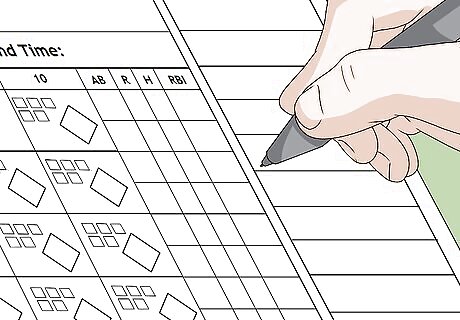
Fill in any extra information on the right side of the scorecard. On some scorecards, there are extra rows or columns on the right side of the page for you to list your name, the temperature, the direction of the sun, or other environmental factors. There may also be a section for taking notes or making observations in this area.Tip: Decide where you want to make personal observations before the game starts. You don’t want to be scrambling for scrap paper in the middle of a big play.
Keeping Track of Plate Appearances

Fill in bubbles or boxes in the top left for each strike or ball. Every pitch is tracked in the individual boxes at the top of each diamond. There are 5 boxes that are aligned in 2 rows to indicate 3 balls and 2 strikes. During an at-bat, every time that an opposing pitcher throws a strike, shade in a box in the row with 2 boxes. Every time that pitcher throws a ball, fill in a box in the row with 3 boxes. There is no fourth box for balls because the at-bat is over if they throw 4 balls. This is also why there is no third box for strikes. If the pitcher throws a strikeout, write a big K in the middle of the diamond. If the batter didn’t swing and took the third strike “looking,” write a backwards K. If a pitcher throws 4 balls and walks the batter, write BB. If they hit a batter, write HBP to indicate that they were hit by a pitch.
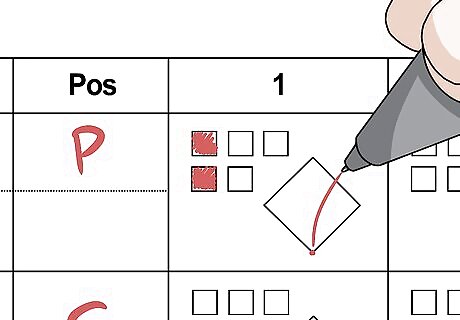
Draw where a ball was hit by illustrating it on the diamond. Every time that a hitter hits the ball and successfully reaches a base, you can draw the location and type of hit on the diamond. To do this, draw a jagged line for a ground ball, a loopy line for a pop-up or fly out, and a straight line for a line drive. Some scorekeepers like to do this so that they can visually represent where a batter hit the ball. You do not have to do this if you don’t want to. It is completely optional, but the information is really helpful if you’re trying to track a hitter’s tendencies.
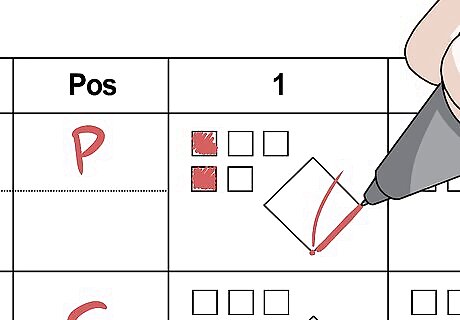
Mark each base that a runner reaches by darkening the path on the diamond. To show that a runner made it to first base, use your pencil or pen to darken the line on the diamond going from home plate to first base. Darken each individual base path that the runner uses, but do not include a base if they get thrown out. For example, if a player hits a single, darken the line from home to first base. If they steal second base successfully, darken the line from first to second. If they get thrown out trying to reach home plate after a single, leave the final 2 base paths blank, since they did not reach them successfully. Some scorekeepers indicate stolen bases with a broken line instead of a solid line. You can write SB, PO, or CS above a base path; these abbreviations stand for stolen base, pick-off, or caught stealing.
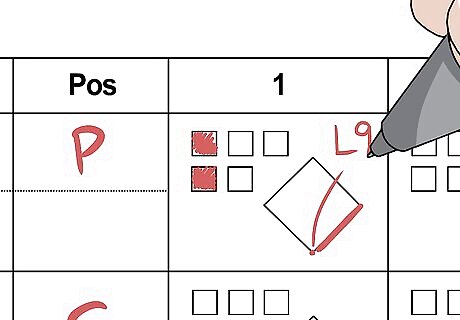
Write the outcome of an at-bat in each box. You can write the outcome in the middle of the diamond or in some open space next to the diamond. If they get a hit, write the abbreviation for the base that they reached after making contact. If they were thrown out, grounded out, or flew out, list each player that touched the ball and separate them by hyphens. Put the type of play in front of the numbers. Position Abbreviations: 1 – Pitcher 2 – Catcher 3 – First Baseman 4 – Second Baseman 5 – Third Baseman 6 – Shortstop 7 – Left Fielder 8 – Center Fielder 9 – Right Fielder The abbreviations for hits are 1B, 2B, 3B, and HR; these abbreviations stand for single, double, triple, and home run. The abbreviations for outs are F, LO, or GO; these stand for flyout, line out, or ground out. Some scorekeepers also use PO for pop out. DP stands for double play. For example, if a player flies out to left field, you would simply write F7 in the diamond (or next to it) to indicate that the batter flied out and the left fielder caught the ball. If the first baseman caught a ground ball and touched first base for the out, you would write GO3. A more complicated play may read DP3-6-1. This means that the defense scored a double play when the first baseman fielded the ball and threw it to the shortstop. The pitcher went to go cover first base and then caught the throw from the shortstop for the final out.
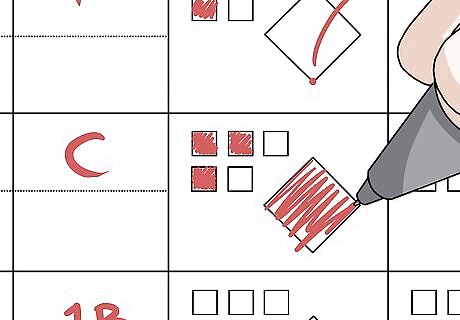
Shade in the entire diamond whenever a player scores. If a player scores, fill in the final line along the base path from third to home. Then, shade in the center of the diamond by holding your pen or pencil at an angle. Use back-and-forth lines to fill in the negative space and indicate that a player scored. If you’re making your play notations outside of the diamond, you can fill in the diamond fully so that it’s dark. If you’re writing the play in the diamond, keep it light so that you can still read the original notation.

Mark errors with an E to show when a player screwed up. Errors refer to mistakes that a player makes which result in an opposing player safely reaching a base when they normally wouldn’t have. Place your E next to the player that caused the hitter to reach the next base. For example, E7 means that the left fielder either dropped the ball or threw it over a player’s head. For a play with an error later in the sequence of the play, put the E next to the player that made the mistake. For example, 4-6-E3 means that the second baseman threw it to the shortstop. The shortstop then threw the ball to the first basemen who proceeded to miss or drop the ball. You don’t include the type of hit on an error because it’s irrelevant; it doesn’t count as a hit for the batter, and it doesn’t count as a hit for the pitcher. It is a separate category of play. It’s up to you who you want to blame on certain plays with unique mistakes. If the shortstop fields a ground ball and throws in the dirt in front of the first baseman, is it the first baseman’s fault that he missed a tough throw, or is it the shortstop’s fault for making a bad throw? This can be scored E6 or 6-E3 based on your assessment of the play.
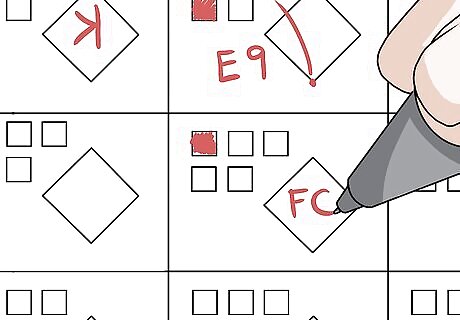
Use FC to indicate a fielder’s choice. A fielder’s choice refers to any play where a base runner safely reached a base on a play where another base runner was called out. It’s important to mark fielder’s choices because they don’t count as hits but they explain how base runners advanced or reached a base. Mark a fielder’s choice with FC. For example, if there is a runner on first base, and the player hits a ground ball to the shortstop, there is a fielder’s choice if the shortstop throws the runner out at second but the batter reaches first base safely. Similarly, if the shortstop ignored the first runner and threw the hitter out at first, this would also be a fielder’s choice. If a player intentionally bunted or hit a fly ball to move a baserunner, it doesn’t count as a fielder’s choice. Write SAC to indicate that a player hit a sacrifice bunt or fly ball.

Track pitcher information using hashmarks. Unless you’re using the opposite side or a second scorecard, there is no way to track a pitcher’s performance every inning. There are only columns and rows to list a pitcher’s overall performance. To make it easy to track a pitcher’s performance every inning, most scorekeepers use small, vertical hashmarks to track hits, earned runs, strike outs, and walks. There are other columns for balks, wins, saves, and innings pitched, but the key information that you need for a single game performance are the number of runs, strikes outs, and walks. These will tell you what a pitcher’s overall performance was like.
Using the Scorecard
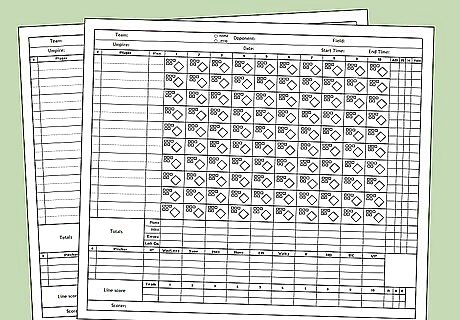
Use a scorecard to pay attention to the game and enjoy it more. Keeping score forces you to pay attention to every single pitch, hit, and play. Since you need to record everything except foul balls, keeping score will tune you into what is happening. For a lot of fans, this makes the game more enjoyable, and the experience of completing a scorecard can be just as satisfying as watching the game. If you just enjoy the act of keeping score, don’t feel like you have to hold on to your scorecard after the game is over. If you like keeping score and you have a child or friend in little league, ask the coach if he’d like access to your scorecards. The coach will be able to use them, and this may free up an assistant coach to do something else.

Add an exclamation point or asterisk if you want to note great plays. If you’re using a scorecard to track a team that you’re coaching, mark each play that deserves additional discussion or praise with an exclamation point or asterisk. You can also use the marks to indicate mistakes that you want to address in practice. You’ll be able to easily look back over the course of the game and remember which specific play needs to be discussed. This is a great way to track game balls or MVP awards for your players.
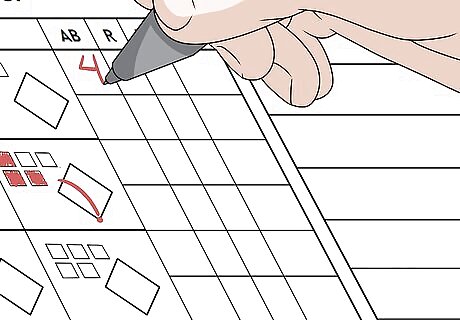
Compile the statistics for each batter at the end of the game. On most scorecards, there are some smaller columns on the right side of the card for you to list the number of singles, doubles, triples, walks, home runs, strikeouts, and walks that a player completed over the course of a game. Store your scorecards for each game to make it easy to calculate total statistics at the end of a season.Tip: This is helpful if you’re a coach and have players returning for the next season. You can figure out who hit the most home runs to put them fourth in the lineup, or who was patient at the plate to have them hit first. Use information like this to help you compose your lineup for next season.

Use the scorecards to identify trends in player behavior over time. Scorecards will also show you how a player is performing over time. If they’re hitting a lot of ground balls, you can work with that player on getting under the ball. If they’re striking out a lot, you can work with them on identifying good pitches. If you see a player hitting a lot of fielder’s choices, stick them either at the top or bottom of your lineup. Fielder’s choices can turn into double plays quite easily, so you don’t want them in the middle of your lineup when the number of base runners is usually high. If a player is particularly good at bunting or hitting sacrifice fly balls, bat them fifth or sixth. This will give them more chances to bring runners in.




















Comments
0 comment